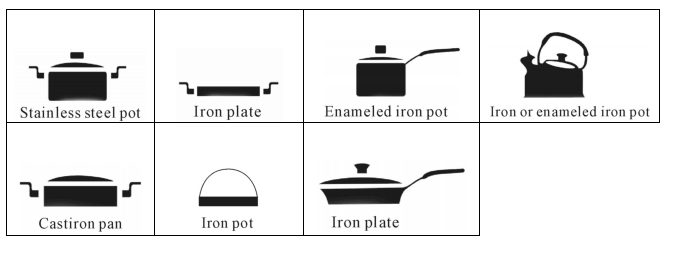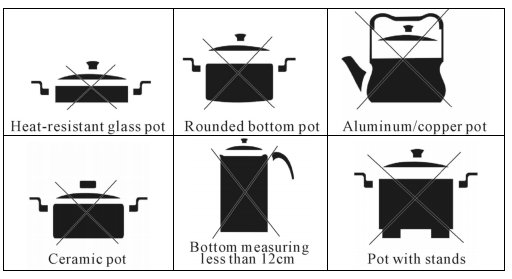Why induction cooker?
An induction cooker is faster and more energy-efficient than a traditional electric cooker. It allows instant control of cooking energy similar to gas burners. Other cooking methods use flames or red-hot heating elements; induction heating heats the pot only. Because the surface of the cook top is heated only by contact with the vessel, the possibility of burn injury is significantly less than with other methods. The induction effect does not directly heat the air around the vessel, resulting in further energy efficiencies. Cooling air is blown through the electronics but emerges
only a little warmer than ambient temperature.
What are the benefits of induction cooker?
This form of flameless cooking has certain advantages over conventional gas flame and electric cookers, as it provides rapid heating, improved thermal efficiency, and greater heat consistency, yet with precise control similar to gas. In situations in which a hotplate would typically be dangerous or illegal, an induction plate is ideal, as it creates no heat itself.
Can all kinds of cookware be used for induction cooker?
No, not all kinds of cookware. But if you have an induction adaptor, then all kinds of cookware can be used for induction cooker.
How to shop
Think you're ready to be converted? First step, visit the website, or write the email or call to us to ask what you want to know more details.
Then determine what you'll want. The first choice is built-in or freestanding. If you already have a separate cooktop, you may be able to easily replace it with a built-in model; standard sizes for induction.
Next, as with any stove installation, you must figure out what kind of wattage your wiring can support. (Though induction is more efficient, it uses the same energy input as a normal stove to achieve higher cooking power output.)
Finally, if you want to embrace the new technology but aren't ready to buy in all the way, consider a hybrid model - a cooktop that offers a combination of radiant electric elements and induction elements. Just contact us to enjoy your good ideas.
You must be interested. that's how. In our latest Appliance Science column, we look at how induction stoves work.
Induction cooker don't heat up themselves: they create heat in the base of the cookware.
How can you have heat without fire?
It's not magic, it's science. Specifically, the science of induction, where strong electric fields can create heat. Induction cooktops use this to heat food without any flames or direct heat, cooking more efficiently than their gas or conventional electric cousins. And this lack of direct heat makes them safer, too: you can even put paper between an induction cooktop and a pan, and it won't catch light.
Induction cooktops are also more efficient than other types of cooking methods. Because the heat is generated inside the base of the pan, they use less electricity than conventional electric cooktops, and can heat things quicker. They are also easier to clean, because the flat glass or ceramic surface has no gaps or grills to collect spilled food, and the food doesn't get burned onto the surface. If you spill something, one quick swipe with a damp cloth will clean it up. They are also quicker to control and more precise, again because the heat is generated inside the cookware, and so react quicker when you turn the dial up or down.
So why aren't they more common? It's partly a comfort thing; most US consumers don't like them because they grew up on gas rings. Cuhe has recently introduced an interesting solution to this problem: a cooktop that projects an LED flame that shows the ring is on, and indicates the heating level.
By the way, because of the way they work, many types of pans just don't heat up with induction cooktops. If you have copper bottom, glass or aluminum pans, they don't get hot when you put them on an induction cooktop.
How they work?
Induction cooktops use one of the odd quirks of electromagnetism: if you put certain materials into a rapidly alternating magnetic field, the material absorbs the energy and heats up. That's because the field creates electrical currents inside the material, and the resistance of the material converts this electrical energy into heat, which is transferred to the food inside the pan.
Right underneath the cooking area of an induction cooktop is a tight spiral of cables, usually made of copper. The cooktop controller pushes an alternating current through this coil, which changes direction usually 20 to 30 times a second. This current flow creates a magnetic field above the coil. As the current alternates back and forth, the magnetic field does the same. If you put a pan on the surface (so it is just above the coil), this magnetic field induces (hence the name) an electrical current in the metal base of the pan. As the magnetic field alternates, this current flows back and forth (which is why it is often called an eddy current, as it swirls around like an eddy in a river). The metal resists this flow, and, like an electric heater, creates heat, which is conducted into the food through the metal of the pan. If you want to gently heat the food, the cooktop pumps a lower current through the coil, so the cookware generates less heat, and the food warms slower.
This process is only works with pans made of certain materials that have specific properties. In order to be heated by the magnetic field, the cookware has to be made of a ferromagnetic material, such as stainless steel or iron.
Electrons have a property called spin, where they can behave like a tiny magnet pointing in a specific direction. The reasons for this are complex (it gets into the crazy world of quantum mathematics and the strange nature of sub-atomic particles), but the basic idea is that, depending on where they are surrounding the nucleus of an atom, electrons spin on one direction (called up) or the other, called down. Ferromagnetic materials have an unbalanced set of electrons, where there are more up-spin electrons than down ones in each atom, or vice versa. This means that the atoms that make up the material can behave like a tiny magnet, and can be influenced by magnetic fields. The larger crystal structure of the material also helps by keeping the atoms aligned so this effect is increased.
Non-ferrous materials like zinc and most non-metals have a balanced set of electrons, where every up-spin electron is matched to a down-spin one. So, they aren't affected by magnetic fields nearly as much as the ferrous ones: the magnetic field only creates very small eddy currents that aren't enough to heat things up.
This does mean that there is an easy way to check if your pans will work with an induction stovetop. If you touch them with a magnet and it sticks to the bottom of the pan, they can be used on an induction cooktop. If the magnet doesn't stick, they won't work with induction. Many pan manufacturers are also now introducing a special mark on the pan that shows they are suitable for use on an induction cooktop: the Induction Mark.
A magnetic induction stove: It's a cooktop that cooks twice as fast - but won't burn the kids' fingers
Magnetic induction may just be the best technology to hit the kitchen since the microwave oven. In the past few years this style of cooktop, which turns magnetic energy into heat, has proved itself a worthy competitor to the traditional choices - gas and electric.
And while induction has only recently joined the list of options, some experts already predict it will soon become an essential value-adding addition for kitchen remodels.
After all, it's faster, safer and more efficient than anything before, says Francisco Migoya, an assistant professor at the Culinary Institute of America in Hyde Park, N.Y. He cooks with it; maybe you should too.
An induction cooktop looks a lot like an electric smooth top, but what goes on beneath the surface is very different. Instead of an electric element, an induction stove is centered around a powerful magnetic copper coil, which creates a high-frequency electromagnetic field when electricity is turned on.
Put a pot made of a magnetic material - like iron or steel - onto that field and the energy gets transferred to it in the form of heat. Nothing else gets hot, only the pot, and you can adjust the field and the heat with the knob, just as with your old stove.
Where it came from
Even the greatest technologies take a while to catch on - though induction has probably taken longer than most. The science behind it was actually discovered back in 1831 by physicist Michael Faraday. It would be more than a century, however, before companies started using induction for anything other than industrial applications. (The same technology is used in generators.)
By the 1970s, manufacturers in Europe and Asia finally began experimenting with cooking uses, and the technology took off quickly on those continents. But American firms weren't as successful at marketing what was then an almost prohibitively expensive product. By 2000 all the induction stoves of that generation had been pulled off the U.S. market
In the past two years, induction manufacturers have returned full-press with a different approach. "They seem to realize that the way to present the product is to the upper-market segment, rather than to storm the walls of the slide-in 30-inch ranges," says Walker.
This time, induction is here to stay.
What's so hot about it
Induction offers several advantages over gas and electric:
It's faster and more precise. Because the unit heats up instantaneously and uses more of the energy, you can boil a quart of water on an induction cooktop in just over two minutes.
It's safer. Since the heat goes straight into the pot without escaping to the cooking surface, you can touch the element even when it's on, a nice safeguard for those with small children at home
It's easier to clean. A common frustration with electric smooth tops is that bits of food become stubborn blemishes once they cook on. Because the induction unit stays cool, drips wipe right up.
What's not so hot
You need certain pots and pans. Only cookware that's ferrous - a fancy word for magnetic - conducts the energy. That means iron, steel and some types of stainless steel (a high nickel content will render it nonmagnetic);
The best test: If a magnet sticks to your pan, it's good. But if you're a ceramic cookware buff or you're wedded to your clear Pyrex saucepan, induction cooking is not for you.
Why Dongguan Zaoshen kitchen Equipment Co.,Ltd.
Focus
We understand the importance of project managing from the initial design to completion and after sales service. We have extensive knowledge of commercial induction cooker technology and its parameters.
Quality
Our aim is not only to achieve superior service but also to make sure that we reach the highes standard of cooking for the end user. Our goal is to make sure every end user will enjoy the cooking.
Payment
Payments alternatives are advance payment (Bank transfer). Western Union & Cash is also acceptable. Please remember to send the scaned recipt of T/T by Email to us for our files, this will speed up the processing of your order.
Warranty
All our products has two year warranty.
1. Usable pans
Steel or cast iron, enameled iron, stainless steel, flat-bottom pans/pots :
2. Non-usable pans
Heat-resistant glass, ceramic container, copper, aluminum pans/pots.


